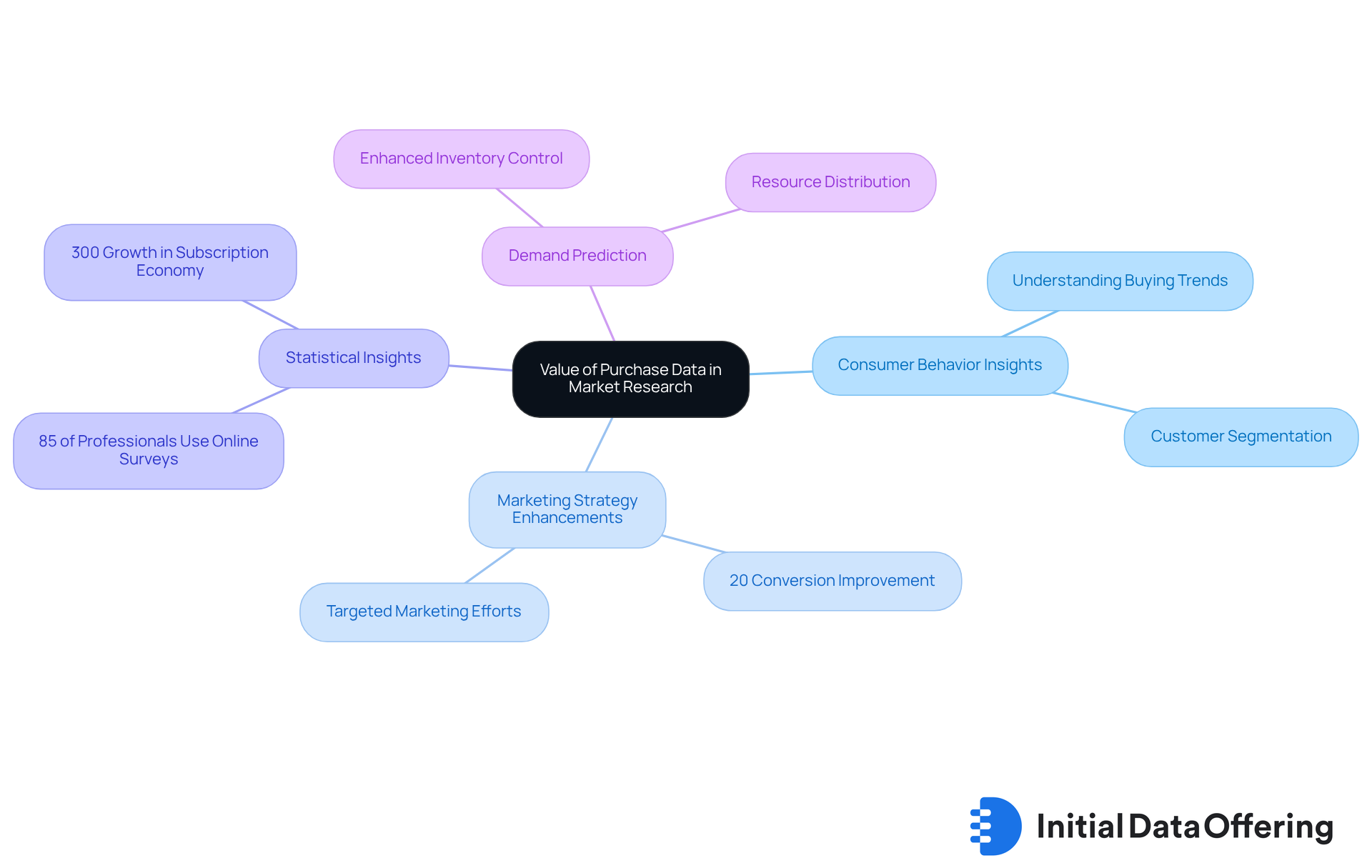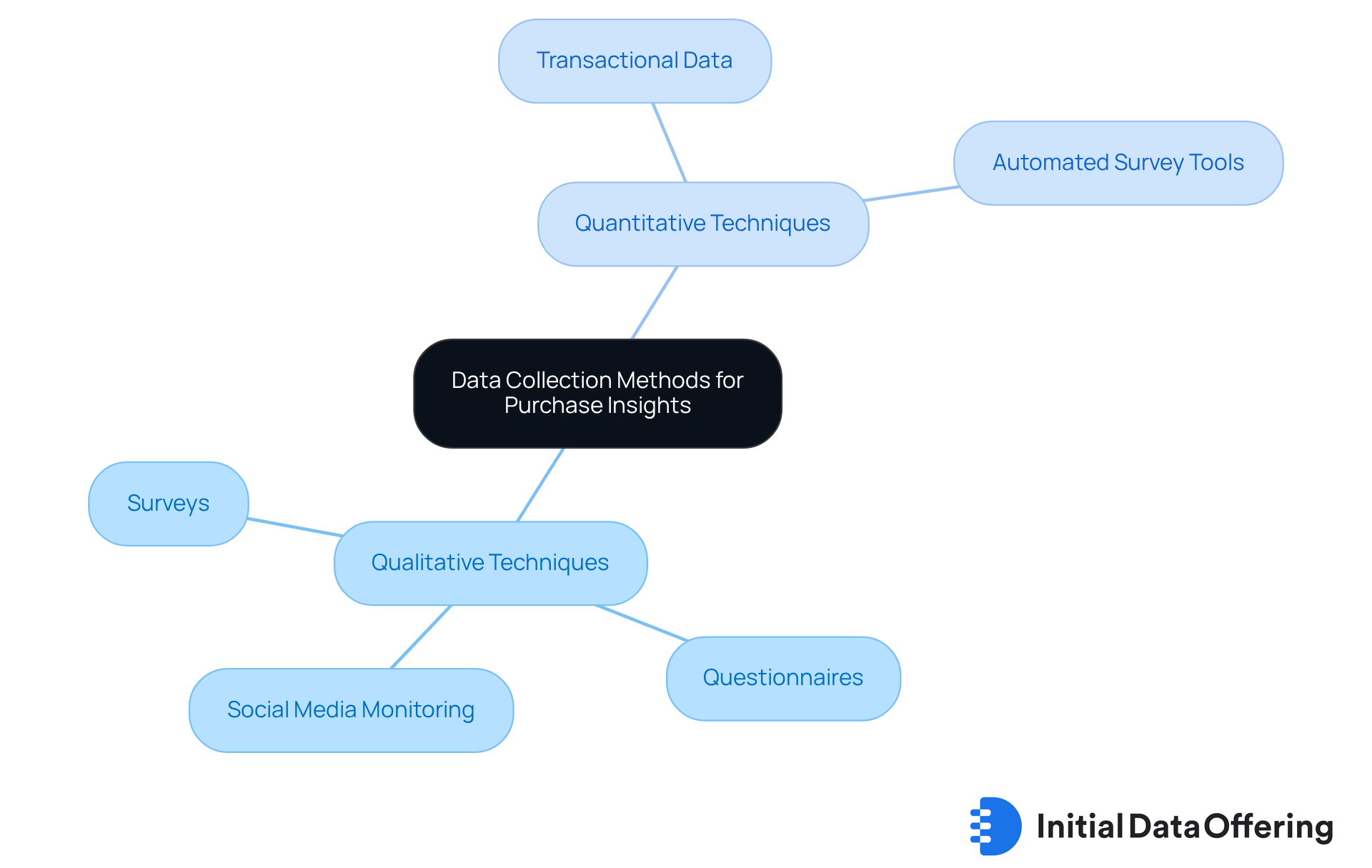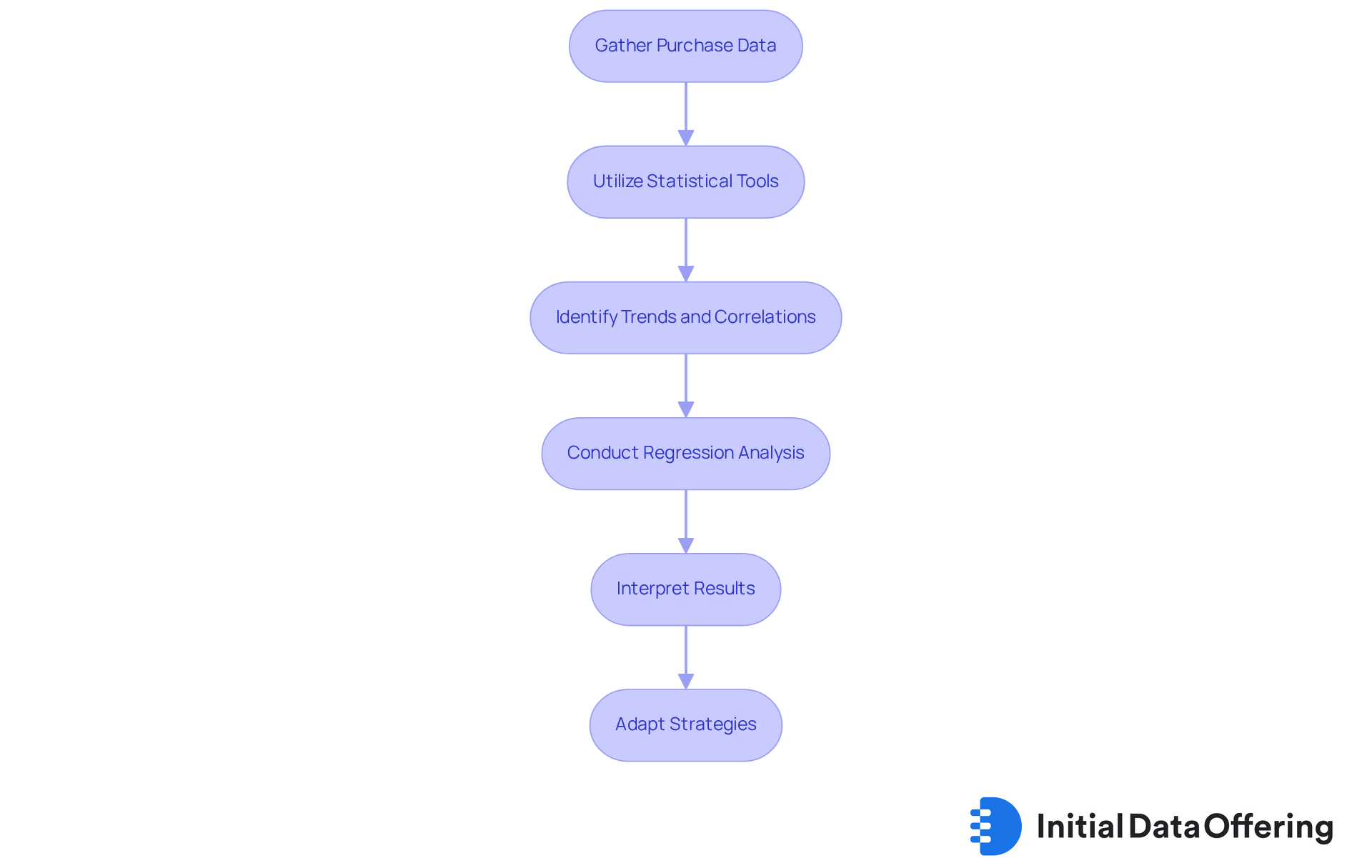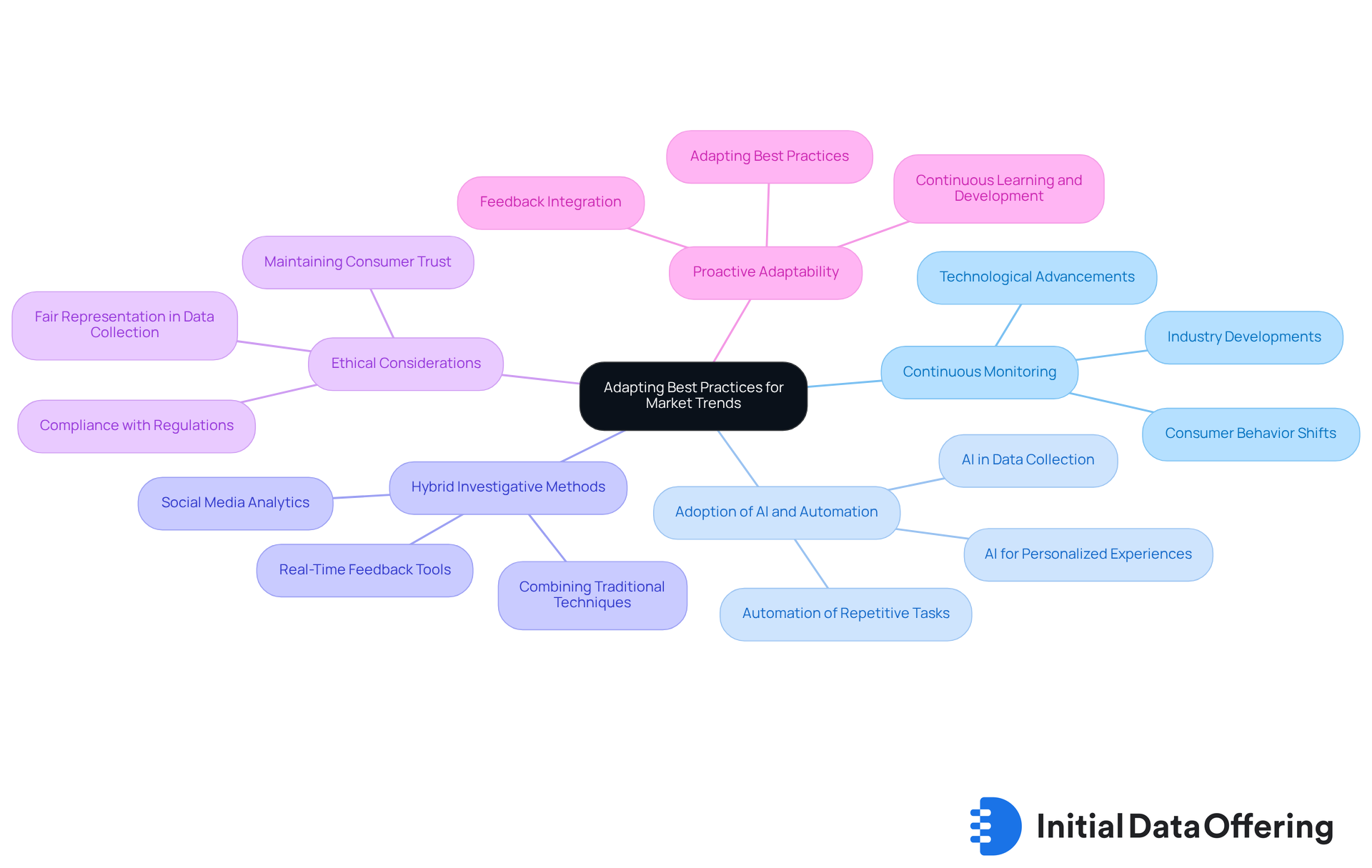Master Purchase Data: Best Practices for Market Research Analysts

Master Purchase Data: Best Practices for Market Research Analysts
Overview
The article emphasizes the best practices for market research analysts to effectively master purchase data, which plays a critical role in understanding consumer behavior and enhancing marketing strategies. By outlining methods for data collection and analysis, it highlights the importance of adaptability in a rapidly changing market. Companies that leverage these practices can significantly improve conversion rates and customer satisfaction.
What features of purchase data can analysts utilize to their advantage? Effective data collection methods include:
- Surveys
- Focus groups
- Customer feedback
These methods provide insights into consumer preferences and trends. The advantage of thorough analysis lies in its ability to reveal patterns and correlations that inform marketing strategies. Ultimately, the benefit is a more targeted approach that resonates with consumers, leading to increased engagement and loyalty.
In conclusion, adopting these best practices is not just a recommendation; it is essential for companies aiming to thrive in today's competitive landscape. By mastering purchase data, analysts can drive actionable insights that lead to tangible improvements in both conversion rates and customer satisfaction.
Introduction
The significance of purchase data in market research is paramount; it acts as a cornerstone for understanding consumer behavior and market dynamics. By effectively harnessing this data, analysts can unveil critical insights that drive strategic marketing decisions and enhance customer satisfaction. However, as market trends evolve and consumer preferences shift, analysts must consider: how can they ensure they are utilizing the most effective data collection methods and analytical techniques? This article explores best practices for mastering purchase data, equipping market research analysts with the essential tools and strategies necessary to thrive in an increasingly competitive landscape.
Understand the Value of Purchase Data in Market Research
Acquisition information serves as an invaluable asset in market research, providing profound insights into consumer behavior and market dynamics. By meticulously analyzing this purchase data, analysts can identify high-performing products, discern seasonal buying trends, and categorize customers based on their purchasing behaviors. Research indicates that companies effectively utilizing purchase data can enhance their marketing strategies, leading to a significant rise in conversion rates. Targeted marketing efforts informed by consumer preferences can yield conversion improvements of up to 20%. Moreover, a striking 85% of industry professionals consistently utilize online surveys as a quantitative approach, underscoring the importance of information gathering in understanding consumer behavior.
Furthermore, leveraging purchase data enables companies to predict demand with enhanced precision, facilitating better inventory control and resource distribution. This proactive strategy not only reduces waste but also ensures that companies can meet consumer demand efficiently, thereby boosting customer satisfaction and fostering loyalty. As the field of consumer analysis evolves, effectively utilizing purchase data will be essential for analysts aiming to drive business expansion and maintain a competitive advantage. With SavvyIQ's AI-driven Recursive Data Engine, analysts gain access to high-quality datasets and advanced entity resolution capabilities, significantly improving their understanding and decision-making processes. Notably, 95% of industry specialists regard advanced analytics as the leading AI technology shaping the sector, emphasizing the crucial role of information in informing future marketing strategies.

Implement Effective Data Collection Methods for Purchase Insights
To collect practical purchasing information, market research analysts should utilize a mix of qualitative and quantitative information-gathering techniques. Surveys and questionnaires serve as efficient instruments for gathering consumer feedback and preferences. These tools not only provide insights into consumer sentiment but also allow for the collection of actionable data. On the other hand, transactional information from sales systems provides quantitative insights into purchase data and purchasing behavior, enabling analysts to understand trends and patterns effectively.
Utilizing online platforms for information collection streamlines the process, enabling real-time data gathering and analysis. Automated survey tools, for example, facilitate the swift collection of extensive datasets. This allows analysts to focus on interpretation rather than information gathering, enhancing efficiency. Furthermore, incorporating social media monitoring tools can yield valuable insights into consumer sentiment and emerging trends, thereby enriching the overall information landscape.
It's essential to engage trusted panel partners to improve the quality of the information collected. This ensures that the findings are dependable and representative of the target market. Adhering to GDPR and other privacy regulations is crucial, as it builds trust with consumers and enhances the credibility of the findings. As market research evolves, embracing innovative methods and technologies, including AI tools for analysis, becomes vital for analysts seeking significant insights from their data. Moreover, addressing challenges like ensuring information quality and validity will provide a more balanced perspective of the collection landscape.
Firms such as Amazon and Netflix exemplify the effective use of surveys and purchase data to understand consumer behavior. Their practical implementation of these techniques showcases how data can drive strategic decision-making. How can your organization leverage similar methods to enhance its understanding of consumer behavior? By adopting these strategies, analysts can gain deeper insights that inform their market research efforts.

Analyze and Interpret Purchase Data for Actionable Insights
Once purchase data is gathered, the next crucial step is to examine and interpret it to derive practical conclusions. Analysts should utilize advanced statistical tools and software to identify trends, correlations, and anomalies within the data. Techniques such as regression analysis are particularly valuable for determining the factors influencing purchasing decisions, as they help investigate the relationships between variables. For example, a retail company employing regression analysis may discover that specific demographic segments are significantly more inclined to purchase eco-friendly products. This understanding can drive targeted marketing campaigns and inform product development strategies tailored to these consumers. Furthermore, visualizing data through interactive dashboards and detailed reports enhances comprehension and enables efficient communication of findings to stakeholders.
Consistently reviewing and refreshing the assessment as new information arises is essential to ensure that conclusions remain relevant and practical. As Marissa Mayer highlights, 'the earlier a company begins gathering information, the quicker they can gain advantages from its findings.' This practice allows companies to adapt swiftly to evolving economic circumstances, ultimately enhancing their strategic decision-making processes. By utilizing these statistical methods, analysts can transform raw purchase data into valuable insights that promote business growth. However, it is crucial to ensure data quality before analysis, as meaningful insights can only be generated when knowledge and analytics are effectively combined.

Adapt Best Practices for Evolving Market Trends
In the fast-paced realm of market analysis, analysts must remain agile and responsive to evolving market trends. This necessity involves continuous monitoring of industry developments, shifts in consumer behavior, and advancements in technology. For instance, the rise of AI and automation in data collection is revolutionizing how analysts gather and interpret data. Adopting these technologies is imperative for enhancing both efficiency and accuracy.
Analysts should also embrace hybrid investigative methods that combine traditional techniques with innovative approaches, such as real-time feedback tools and social media analytics. This adaptability not only elevates the quality of insights but also positions analysts as thought leaders within their field. How can these methods improve your analysis practices?
Moreover, staying informed about ethical considerations and regulatory changes is crucial for maintaining consumer trust and ensuring compliance. By proactively adapting best practices, market research analysts can guarantee that their strategies remain effective and relevant. This proactive stance ultimately drives better outcomes for their organizations, reinforcing the importance of adaptability in a rapidly changing environment.

Conclusion
Mastering the intricacies of purchase data is essential for market research analysts who seek to gain a competitive edge and drive business success. This article underscores the critical role that purchase data plays in understanding consumer behavior, enhancing marketing strategies, and enabling effective decision-making. By leveraging this data, analysts can identify trends and customer preferences, implementing proactive strategies that lead to improved customer satisfaction and loyalty.
Key insights discussed include the importance of employing a mix of qualitative and quantitative data collection methods, such as surveys and transactional data, to gather comprehensive consumer insights. The use of advanced statistical tools for analyzing this data allows analysts to derive actionable insights that inform marketing campaigns and product development. Additionally, adapting to evolving market trends through innovative techniques and technologies ensures that analysts remain relevant and capable of meeting changing consumer demands.
As the landscape of market research continues to evolve, embracing best practices in data collection and analysis becomes paramount. Organizations are encouraged to adopt these strategies and tools to enhance their understanding of market dynamics, ultimately leading to more effective decision-making and improved business outcomes. By prioritizing the value of purchase data, analysts can unlock new opportunities and drive sustainable growth in an increasingly competitive marketplace.
Frequently Asked Questions
What is the significance of purchase data in market research?
Purchase data is invaluable in market research as it provides insights into consumer behavior and market dynamics, helping analysts identify high-performing products, seasonal buying trends, and categorize customers based on their purchasing behaviors.
How can companies benefit from effectively utilizing purchase data?
Companies that effectively utilize purchase data can enhance their marketing strategies, leading to significant increases in conversion rates, with targeted marketing efforts potentially yielding improvements of up to 20%.
What role do online surveys play in understanding consumer behavior?
Online surveys are a widely used quantitative approach, with 85% of industry professionals consistently utilizing them to gather information that helps in understanding consumer behavior.
How does leveraging purchase data aid in demand prediction?
Leveraging purchase data allows companies to predict demand with greater precision, facilitating better inventory control and resource distribution, which helps in reducing waste and meeting consumer demand efficiently.
What impact does effective use of purchase data have on customer satisfaction?
Effective use of purchase data boosts customer satisfaction by ensuring that companies can meet consumer demand efficiently, which in turn fosters customer loyalty.
How is SavvyIQ's AI-driven Recursive Data Engine beneficial for analysts?
SavvyIQ's AI-driven Recursive Data Engine provides analysts with access to high-quality datasets and advanced entity resolution capabilities, significantly improving their understanding and decision-making processes.
What is the perception of advanced analytics among industry specialists?
A notable 95% of industry specialists regard advanced analytics as the leading AI technology shaping the sector, highlighting its crucial role in informing future marketing strategies.